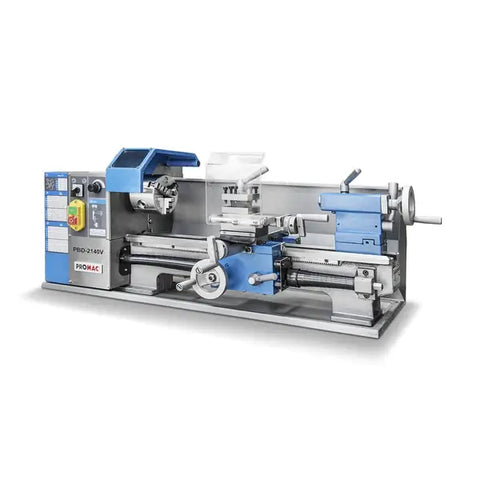
Safety Check: Are Lathes Deadly? Know the Risks
When it comes to operating heavy machinery, safety should always be the top priority. This holds true for lathes, which are powerful machines commonly used in woodworking and metalworking industries. If not used with caution, lathes can pose serious hazards to operators and those working around them. It's essential to understand the potential risks and importance of proper lathe safety measures to ensure a safe work environment.
Lathes can be dangerous, but it is important to note that they are not inherently deadly. By maintaining awareness and following specific safety guidelines, the risks associated with lathe machines can be significantly reduced. So, let's explore some of the hazards that come with working on lathes and understand why lathe safety is of utmost importance.

Key Takeaways:
- Operating lathes without proper safety precautions can lead to accidents and injuries.
- Understanding the potential hazards associated with lathe machines is crucial for maintaining a safe work environment.
- Proper training for lathe operators is essential to ensure they can operate the machines safely and efficiently.
- Following established lathe safety guidelines significantly reduces the risk of accidents and injuries.
- Always prioritize safety and remain vigilant when working with or around lathes.
Lathe Safety Tips to Reduce Risks
When it comes to working on lathes, prioritizing safety is of utmost importance. By following proper guidelines and implementing the necessary precautions, you can significantly reduce the risks associated with operating a lathe machine. Here are some essential lathe safety tips to keep in mind:
1. Proper Lathe Operator Training
To ensure safe operation of a lathe, it is crucial for all operators to receive thorough training. Proper training provides operators with the necessary knowledge and skills to handle the machine safely and effectively. It covers important aspects such as machine operation, maintenance, and emergency procedures. By investing in comprehensive training programs, employers can help minimize accidents and create a secure working environment.
2. Adhere to Lathe Safety Guidelines
Following lathe safety guidelines is essential in preventing accidents and injuries. These guidelines cover various aspects such as personal protective equipment, machine guarding, and safe work practices. It is crucial for operators to always wear appropriate protective gear, such as safety glasses, gloves, and hearing protection. Additionally, guards should be in place to protect operators from rotating parts and flying debris. By strictly adhering to these guidelines, the risk of accidents can be significantly reduced.
3. Maintain a Clean and Organized Workspace
A clean and organized workspace is essential for safe lathe operation. Cluttered work areas can increase the risk of accidents and make it difficult to maneuver around the machine. It is important to keep the area around the lathe clear of any unnecessary items and properly store tools and equipment. Regularly inspecting and maintaining the lathe is also crucial to ensure its proper functioning and minimize the risk of accidents caused by faulty equipment.
4. Use Proper Cutting Tools and Techniques
Using the correct cutting tools and techniques is vital for safe lathe operation. Operators should select cutting tools that are appropriate for the material being worked on, ensuring they are sharp and in good condition. Employing proper cutting techniques, such as avoiding excessive cutting speeds or depths, can help prevent tool breakage and other potential hazards. Regularly inspecting and replacing worn-out tools will also contribute to safer lathe operation.
5. Regularly Evaluate and Improve Safety Procedures
Continuously assessing and improving safety procedures is essential to maintaining a safe working environment. Conducting regular safety audits and involving operators in the process can help identify potential hazards and implement necessary improvements. Encouraging open communication and providing a reporting system for near misses or incidents enables proactive measures to be taken to prevent accidents in the future.

Common Lathe Safety Tips
| Safety Tips | Description |
|---|---|
| 1. Proper Training | Receive comprehensive lathe operator training to safely operate the machine. |
| 2. Follow Guidelines | Adhere to lathe safety guidelines, including the use of personal protective equipment and machine guarding. |
| 3. Maintain Workspace | Keep the work area clean and organized to avoid accidents and improve maneuverability. |
| 4. Use Proper Tools | Select and use the right cutting tools and techniques for safe lathe operation. |
| 5. Evaluate Procedures | Regularly assess and improve safety procedures to ensure a safe working environment. |
By following these lathe safety tips and guidelines, you can minimize the likelihood of accidents and injuries, creating a safer working environment for lathe operators and those working nearby.

Conclusion
In conclusion, the use of lathes can pose risks and potential dangers if not handled correctly. However, it is important to note that lathes are not inherently deadly machines. By taking the necessary precautions and following proper safety guidelines, individuals can significantly reduce the associated risks and create a safer working environment.
Reducing lathe risks starts with comprehensive training for operators. It is crucial for individuals to receive proper instruction on the safe operation of lathes, including the correct handling of tools, understanding the machine's capabilities and limitations, and recognizing potential hazards. By equipping themselves with the required skills and knowledge, operators can minimize the chances of accidents and injuries occurring.
Staying safe around lathes also involves adhering to essential safety measures. This includes wearing appropriate personal protective equipment (PPE) such as safety glasses, gloves, and protective clothing. Regular equipment maintenance, proper installation of guards, and routine inspections are also important to ensure the machine operates safely and efficiently.
In conclusion, a vigilant approach is necessary when working around lathes. It is crucial to remain focused, avoid distractions, and follow all safety protocols. By prioritizing training, adhering to safety measures, and staying diligent, individuals can drastically reduce the risks associated with operating lathes and create a safe and secure working environment for themselves and their colleagues.

